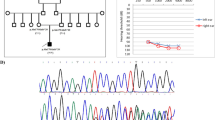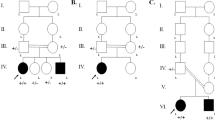Abstract
Purpose
Although recessive mutations in GJB2 are the common genetic etiology of sensorineural hearing impairment (SNHI), variants in LRTOMT gene were also identified, mostly in Middle East and North African populations.
Methods
Using Sanger sequencing we screened the exon 7 of LRTOMT in a cohort of 128 unrelated Mauritanian children with congenital deafness.
Results
Only one biallelic missense mutation, predicted as pathogenic (c.179 T > C;p.Leu60Pro) was found at homozygous state in four families. This variant, not reported before, showed a deleterious effect by SIFT (score: 0.01) and a disease-causing effect by Mutation Taster (prob: 1). Exploration of the encoded protein 3D structure revealed a disruption from an organized α helix (in the normal protein structure) into a random conformation. Early fitting of a cochlear implant seemed to improve the audition ability of the mutation carrier.
Conclusion
Further screening using a panel of deafness genes may expose other variants underlying hearing impairment in our population.



Similar content being viewed by others
Availability of data and materials
The datasets on variants generated during the current study are available from the corresponding author on reasonable request.
References
Wilson BS, Tucci DL, Merson MH, O’Donoghue GM (2017) Global hearing health care: New findings and perspectives. Lancet 390:2503–2512. https://doi.org/10.1016/S0140-6736(17)31073-5
Sheffield AM, Smith RJ (2019) The epidemiology of deafness. Cold Spring Harb Perspect Med. https://doi.org/10.1101/cshperspect.a033258
Kimberly A, Gifford MD, Michael G, Holmes HH, Bernstein DO (2009) Hearing loss in children. Pediatr Rev 30(6):207–215. https://doi.org/10.1542/pir.30-6-207
Prasansuk S (2000) Incidence/prevalence of sensorineural hearing impairment in Thailand and Southeast Asia. Audiology 39(4):207–211. https://doi.org/10.3109/00206090009073080
Elahi MM, Elahi F, Elahi A, Elahi SB (1998) Paediatric hearing loss in rural Pakistan. J Otolaryngol 27(6):348–353
Smith AW (2001) WHO activities for prevention of deafness and hearing impairment in children. Scan Audiol Suppl 53:93–100. https://doi.org/10.1080/010503901750166808
Zakzouk S (2002) Consanguinity and hearing impairment in developing countries: a custom to be discouraged. J LaryngolOtol 116:811–816. https://doi.org/10.1258/00222150260293628
Moctar EC, Riahi Z, El Hachmi H, Veten F, Meiloud G, Bonnet C, Abdelhak S, Errami M, Houmeida A (2016) Etiology and associated GJB2 mutations in Mauritanian children with non-syndromic hearing loss. Eur Arch Otorhinolaryngol 273:3693–3698. https://doi.org/10.1007/s00405-016-4036-z
MosratiMA F-Z, Elgaaied AB et al (2021) Deep analysis of the LRTOMT c.242G>A variant in non-syndromic hearing loss North African patients and the Berber population: Implications for genetic diagnosis and genealogical studies. Mol Genet Genomic Med 9:e1810. https://doi.org/10.1002/mgg3.1810
Ichinose A, Moteki H, Hattori M, Nishio SY, Usami SI (2015) Novel mutations in LRTOMT associated with moderate progressive hearing loss in autosomal recessive inheritance. Ann Otol Rhinol Laryngol 124(Suppl 1):142S-S147. https://doi.org/10.1177/0003489415575043
Charif M, Bounaceur S, Abidi O et al (2012) The c.242G>A mutation in LRTOMT gene is responsible for a high prevalence of deafness in the Moroccan population. Mol Biol Rep 39(12):11011–11016. https://doi.org/10.1007/s11033-012-2003-3
Ahmed ZM, Masmoudi S, Kalay E et al (2008) Mutations of LRTOMT a fusion gene with alternative reading frames cause non syndromic deafness in humans. Nat Genet 40:1335–1340. https://doi.org/10.1038/ng.245
Riahi Z, Bonnet C, Zainine R, Louha M, Bouyacoub Y, Laroussi N, Chargui M, Kefi R, Jonard L, Dorboz I, Hardelin JP, Salah SB, Levilliers J, Weil D, McElreavey K, Boespflug OT, Besbes G, Abdelhak S, Petit C (2014) Whole exome sequencing identifies new causative mutations in Tunisian families with non-syndromic deafness. PLoS ONE 9:e99797. https://doi.org/10.1371/journal.pone.0099797
Abrusán G, Joseph A (2016) Marsh Alpha Helices Are More Robust to Mutations than Beta Strands. PLoS Comput Biol 12(12):e1005242
Schafer IA, Scriver CR, Efron ML (1962) Familial hyperprolinemia, cerebral dysfunction and renal anomalies occuring in a family with hereditary nephropathy and deafness. N Engl J Med 267:51–60. https://doi.org/10.1056/NEJM196207122670201
Batissoco AC, Auricchio MTBM, Kimura L, Tabith-Junior A, Mingroni-Netto RC (2009) A novel missense mutation p.L76P in the GJB2 gene causing non-syndromic recessive deafness in a Brazilian family Brazilian. J Med Biol Res 42:168–171. https://doi.org/10.1590/S0100-879X2009000200004
Adam M, De RA, Meşe G, Li L, Sellitto C, Brink PR, Gong X, White TW (2009) The cataract causing Cx50-S50P mutant inhibits Cx43 and intercellular communication in the lens epithelium. Exp Cell Res 315(6):1063–1075. https://doi.org/10.1016/j.yexcr.2009.01.017
Hadrami M, Bonnet C, Veten F, Zeitz C et al (2018) A novel missense mutation of GJA8 causes congenital cataract in a large Mauritanian family. Eur J Ophthalmol 29(6):621–628. https://doi.org/10.1177/1120672118804757
Alexander AM, Edward R, Dulce EC (2013) Proline: The distribution, frequency, positioning, and common functional roles of proline and polyproline sequences in the human proteome. PLoS ONE 8(1):e53785. https://doi.org/10.1371/journal.pone.0053785
Gibriel AA, Abou-Elew MH, Masmoudi S (2019) Analysis of p.Gly12Valfs*2, p.Trp24* and p.Trp77Arg mutations in GJB2and p.Arg81Gln variant in LRTOMT among non-syndromic hearing loss Egyptian patients: implications for genetic diagnosis. Mol Biol Rep 46:2139–2145. https://doi.org/10.1007/s11033-019-04667-0
Vernet R (1986) La Mauritanie, des Origines au Début de l'Histoire. Centre Cultural Francais Nouakchott
Crowgey EL, Washburn MC, Kolb EA, Puffenberger EG (2019) Development of a novel next-generation sequencing assay for carrier screening in old order amish and mennonite populations of Pennsylvania. J Mol Diagnost 21(4):687–694. https://doi.org/10.1016/j.jmoldx.2019.03.004
Babanejad M, Fattahi Z, Bazazzadegan N et al (2012) A comprehensive study to determine heterogeneity of autosomal recessive non-syndromic hearing loss in Iran. Med Genet 10:2485–2492. https://doi.org/10.1002/ajmg.a.35572
Vanwesemael M, Schrauwen I, Ceuppens R et al (2011) A 1 bp deletion in the dual reading frame deafness gene LRTOMT causes a frameshift from the first In to the second reading frame. Med Genet. https://doi.org/10.1002/ajmg.a.34096
Wang R, Han S, Khan A, Zhang X (2017) Molecular analysis of twelve Pakistani families with non-syndromic or syndromic hearing loss. Genet Test Mol Biomark 21(5):316–321. https://doi.org/10.1089/gtmb.2016.0328
Marková S, Brožková DS, Mészárosová A et al (2016) Mutations in eight small DFNB genes are not a frequent cause of non-syndromic hereditary hearing loss in Czech patients. Int J Pediatr Otorhinolaryngol 86:27–33. https://doi.org/10.1016/j.ijporl.2016.04.005
Du X, Schwander M, Marie YE et al (2008) A catechol-O-methyltransferase that is essential for auditory function in mice and humans. PNAS 105(38):14609–14614. https://doi.org/10.1073/pnas.0807219105
Sarmadi A, Nasrniya S, Soleimani Farsani M et al (2020) A novel pathogenic variant in the LRTOMT gene causes autosomal recessive non-syndromic hearing loss in an Iranian family. BMC Med Genet 21:127. https://doi.org/10.1186/s12881-020-01061-7
Wu CC, Lin YH, Liu TC, Lin KN, Yang WS, Hsu CJ et al (2015) Identifying children with poor cochlear implantation outcomes using massively parallel sequencing. Medicine 94:e1073. https://doi.org/10.1097/MD.0000000000001073
Acknowledgements
We thank all the families for their participation to the study. This work was supported by Fondation pour l’Audition (FPA-IDA05) and the ANRSI-Mauritania.
Funding
The authors declare that no funds or grants were received during the preparation of this manuscript.
Author information
Authors and Affiliations
Contributions
MS, ECM, SMB, CTH and VT collected and organized patients’ files. AD and LAV examined patients and analyzed clinical data. CB, CP and AH contributed in paper conception and writing of the manuscript. All authors read and approved the final manuscript.
Corresponding author
Ethics declarations
Competing interests
The authors declare that they have no competing interests.
Ethics approval and consent to participate
Research in this study has been performed in accordance with the Declaration of Helsinki and was approved by an appropriate ethics committee: the Ethics Committee of the University of Nouakchott, Mauritania (ref. no002/2020/CE/UNA). We confirm that all methods were performed in accordance with the relevant guidelines and regulations.
Consent for publication
Informed consent was obtained from all study participants. The informed consent of all patients was also obtained for the data publication.
Additional information
Publisher's Note
Springer Nature remains neutral with regard to jurisdictional claims in published maps and institutional affiliations.
Rights and permissions
Springer Nature or its licensor (e.g. a society or other partner) holds exclusive rights to this article under a publishing agreement with the author(s) or other rightsholder(s); author self-archiving of the accepted manuscript version of this article is solely governed by the terms of such publishing agreement and applicable law.
About this article
Cite this article
Salame, M., Bonnet, C., Moctar, E.C.M. et al. Identification a novel pathogenic LRTOMT mutation in Mauritanian families with nonsyndromic deafness. Eur Arch Otorhinolaryngol 280, 4057–4063 (2023). https://doi.org/10.1007/s00405-023-07907-z
Received:
Accepted:
Published:
Issue Date:
DOI: https://doi.org/10.1007/s00405-023-07907-z




